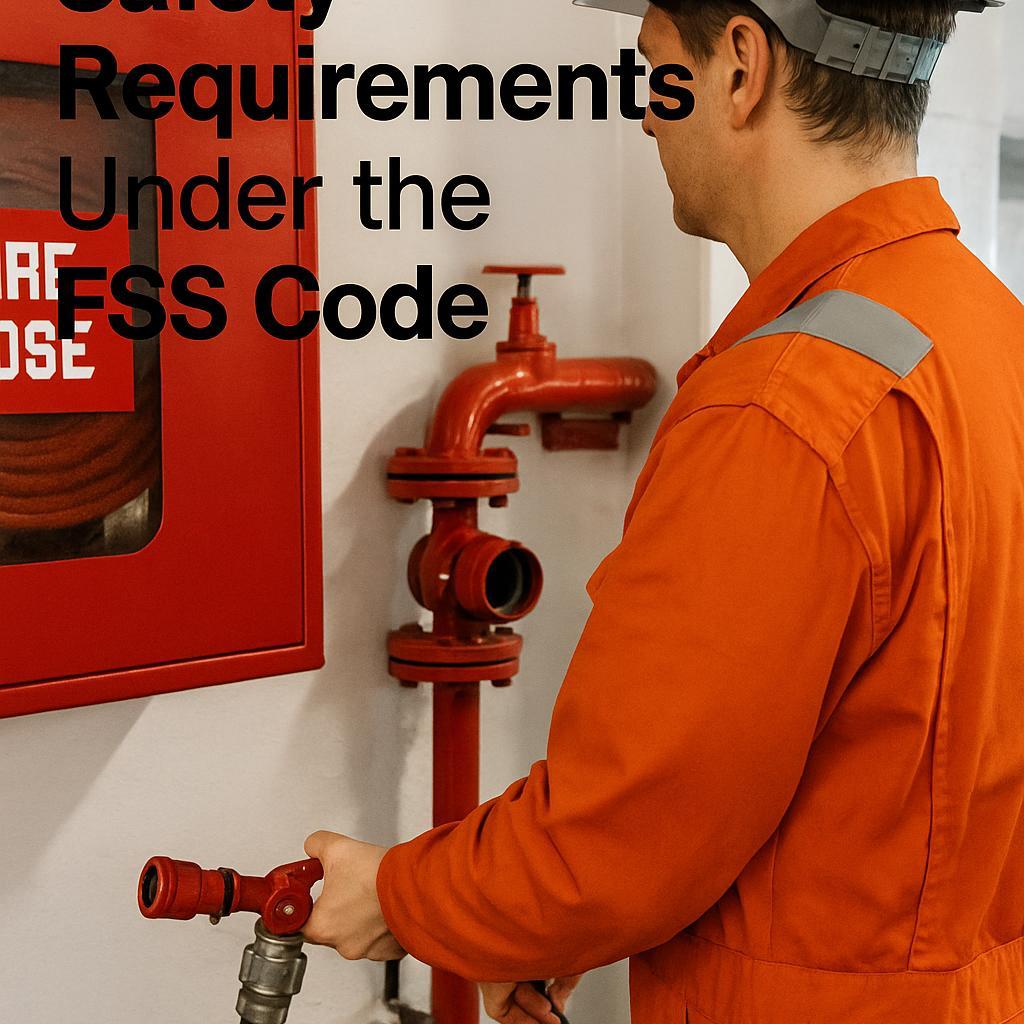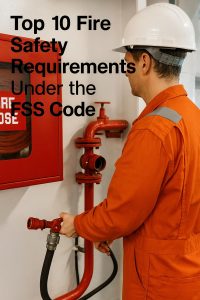Discover the top 10 fire safety requirements under the FSS Code that protect ships and crew. Learn how international fire prevention rules save lives and prevent disasters at sea.
Why Fire Safety at Sea Can’t Be Taken Lightly
Fire aboard a ship is not like fire on land. There are no fire trucks rushing in from the next street over. There’s only your crew, your equipment, and the protocols you’ve trained for. In the middle of the ocean, your best defence against catastrophe is prevention, detection, and suppression—and that’s exactly what the International Code for Fire Safety Systems (FSS Code) provides.
Developed under the SOLAS Convention and maintained by the International Maritime Organization (IMO), the FSS Code details minimum fire safety standards for everything from cargo ships and ferries to oil tankers and cruise liners. It’s not optional. Compliance is mandatory for all SOLAS ships.
This article breaks down the Top 10 Fire Safety Requirements under the FSS Code, offering practical insight, real-world examples, and why these rules remain crucial in 2025 and beyond.
Understanding the FSS Code and Its Importance
The FSS Code was first adopted in 2000 (through IMO Resolution MSC.98(73)) to harmonize fire safety requirements found across SOLAS chapters, particularly Chapter II-2. Since then, the code has been updated regularly to reflect advancements in technology and lessons learned from real maritime incidents.
Whether it’s the fire-retardant bulkheads in accommodation spaces or the fixed fire-extinguishing systems in engine rooms, the FSS Code exists to limit the spread of fire, protect lives, and preserve the ship’s integrity during an emergency.
In 2023, IMO updated parts of the FSS Code to reflect concerns about alternative fuels, lithium-ion battery fires, and automated detection systems—showing how this regulatory framework evolves with modern maritime risks.
1. Fire Detection and Alarm Systems
Mid-summary:
Early detection is everything. Fires that are caught late are harder to contain—and far more deadly.
Key Requirements:
-
Smoke and heat detectors must be installed in accommodation areas, control stations, service spaces, and machinery spaces.
-
The system must automatically alert the bridge or central fire control station.
-
It must operate even under power failure conditions, using battery backup.
Technological Advances:
Modern systems use addressable detectors (each unit has a unique ID) that pinpoint the exact location of the fire, drastically reducing response times. Some vessels even use AI-enhanced analytics for predictive fault monitoring.
2. Fixed Gas Fire-Extinguishing Systems (e.g., CO₂ Systems)
Mid-summary:
These systems are the last line of defence when fire breaks out in enclosed spaces like engine rooms or cargo holds.
Key Requirements:
-
CO₂ systems must be remotely operable and able to flood the affected space within 2 minutes.
-
Storage cylinders must have pressure relief valves and burst disks.
-
The release must include visual and audible alarms before activation to protect personnel.
Example:
The MV Yantian Express cargo fire in 2019 led to a CO₂ system activation that contained the fire in one hold section, preventing a total loss.
3. Portable Fire Extinguishers
Mid-summary:
These are the most accessible fire-fighting tools and often the first to be used when a fire starts.
Key Requirements:
-
SOLAS requires one portable extinguisher per 50 m² of deck area.
-
Each type of fire (Class A, B, C) must be covered depending on the space (e.g., CO₂ for electrical, foam for fuel).
-
Extinguishers must be serviced annually and clearly marked.
Inspection Note:
During Paris MoU port state control inspections, inoperative or missing extinguishers remain one of the top deficiencies reported.
4. Fire Main Systems and Hydrants
Mid-summary:
Water may not extinguish all fires—but it’s essential for cooling hot surfaces and suppressing flames.
Key Requirements:
-
Ships must have a dedicated fire main, capable of supplying two jets of water simultaneously to any part of the ship.
-
Fire pumps must be independent from bilge pumps.
-
Isolating valves are required to maintain pressure even if a section is damaged.
Real-World Example:
After a cargo hold fire on the Grande America (2019), crew used hydrants on deck to cool container stacks and prevent fire spread until help arrived.
5. Fixed Foam Fire-Extinguishing Systems
Mid-summary:
For oil tankers and ships carrying flammable liquids, water alone isn’t enough. Foam is required to smother the fire and prevent vapor release.
Key Requirements:
-
Foam systems must cover the entire tank deck and pump room.
-
Capable of producing foam for at least 20 minutes.
-
Must include remote activation and backup pumps.
Recent Development:
IMO is reviewing compatibility of traditional foams with biofuels and alternative fuels, as they may require different chemical formulations.
6. Smoke Control and Ventilation Systems
Mid-summary:
Smoke inhalation causes more deaths than burns. Controlled airflow saves lives.
Key Requirements:
-
Fire dampers must automatically close in the event of a fire.
-
Systems must prevent smoke from traveling between compartments.
-
Pressurization is required for escape routes and stairways.
Tech Insight:
Newer systems include smart ductwork sensors and automated shutdown logic, reducing crew error and ensuring isolation of affected areas.
7. Emergency Escape Breathing Devices (EEBDs)
Mid-summary:
If smoke fills an engine room or passageway, crew need to breathe and escape—fast.
Key Requirements:
-
At least two EEBDs in the engine room and one in other key areas like pump rooms.
-
Must supply minimum 10 minutes of breathable air.
-
Clearly marked, with easy grab access during emergencies.
Best Practice:
Many vessels conduct hands-on training using expired EEBDs to ensure crew don’t panic when using them during an actual emergency.
External Reference:
Lloyd’s Register – EEBD Requirements
8. Fire Control Plans
Mid-summary:
A well-labeled, accessible fire control plan ensures every crew member knows where safety equipment is—and how to use it.
Key Requirements:
-
Plans must be posted at prominent locations (e.g., bridge, accommodation areas).
-
Must include location of extinguishers, hydrants, dampers, fire doors, and emergency exits.
-
Updated during every dry dock inspection or ship modification.
Crew Impact:
During abandon ship drills, fire control plans are often used to review roles and responsibilities, improving coordination.
9. Firefighter’s Outfits
Mid-summary:
When it’s too dangerous for ordinary crew, trained personnel in full gear must enter the scene.
Key Requirements:
-
At least two complete firefighter outfits on cargo ships; four or more on passenger vessels.
-
Includes thermal protective clothing, self-contained breathing apparatus (SCBA), and communication devices.
-
Must be stored in readily accessible locations, near likely fire zones.
New Standards:
SCBA units are now required to have audible low-air alarms and pressure indicators.
10. Drills, Training, and Maintenance
Mid-summary:
No system works if it isn’t understood, maintained, or tested. Human factors remain critical.
Key Requirements:
-
Weekly checks of detection systems and fire pumps.
-
Monthly checks on all extinguishers, hoses, and foam systems.
-
Crew must participate in fire drills every month.
-
Training must be STCW-compliant and documented in the SMS (Safety Management System).
Evidence-Based Impact:
According to the Nautical Institute, ships with rigorous fire training programs are 50% less likely to suffer crew injuries during fire emergencies.
–
FAQ: Top Questions About the FSS Code and Fire Safety at Sea
Q1: Is the FSS Code mandatory for all ships?
It applies to all SOLAS ships—generally vessels of 500 GT or more engaged in international voyages.
Q2: How often must fire detection systems be tested?
Weekly checks and monthly detailed inspections are required. Annual servicing must be carried out by certified technicians.
Q3: What is the difference between CO₂ and foam systems?
CO₂ is ideal for enclosed machinery spaces; foam is used for flammable liquid fires, such as tank decks or cargo areas.
Q4: Do port state inspections check FSS compliance?
Absolutely. Fire safety violations are among the top reasons for ship detentions under Paris MoU and Tokyo MoU regimes.
Q5: Are older ships exempt from newer FSS Code rules?
Not always. While some new requirements apply only to ships constructed after a certain date, flag states may mandate retrofitting.
Conclusion: Fire Safety Is More Than Compliance—It’s Survival
Every requirement in the FSS Code was written in response to a real tragedy, a close call, or a future risk. Whether it’s a burning engine room or a smoke-filled accommodation block, these systems aren’t just technical features—they’re lifelines.
For maritime professionals, understanding the FSS Code isn’t about ticking boxes. It’s about ensuring your ship, your crew, and your cargo are prepared for the worst—and trained to come out alive.
References
-
International Maritime Organization. (n.d.). Fire Safety Systems (FSS) Code
-
DNV. (2021). Fire Safety Compliance
-
Lloyd’s Register. (n.d.). Firefighting Equipment and PPE Standards
-
IACS. (2022). Unified Fire Safety Requirements
-
Paris MoU. (2023). Annual Port State Control Report
-
Nautical Institute. (2023). Human Factors and Emergency Response at Sea
-
ABS. (2022). Foam Firefighting Systems on Tankers
-
IMAREST. (n.d.). Smoke Management in Enclosed Marine Spaces


